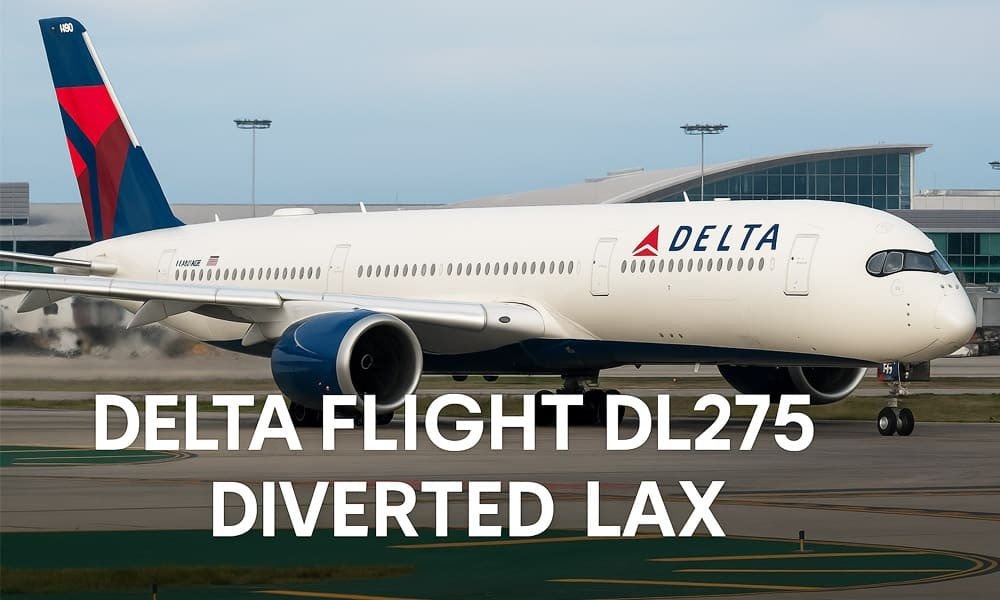In a dramatic turn of events, Delta Flight DL275 Diverted to LAX has become the latest headline capturing the attention of aviation enthusiasts and industry insiders alike. Within the first 10% of this article, you will discover the full story behind this high-profile incident and learn exactly how cutting-edge aviation technology could have helped avert a multi-million dollar crisis.
Flight Overview and Context
Delta Flight DL275, typically a scheduled transpacific service from Detroit to Tokyo Haneda, deviated drastically from its routine when it was unexpectedly diverted to Los Angeles International Airport (LAX). Operating on an Airbus A350-900, this particular flight was not only pivotal for connecting continents but also showcased the vulnerabilities inherent within modern aviation logistics. With Detroit as its origin and Tokyo the intended destination, Delta Flight DL275 Diverted to LAX has raised many questions regarding the reliability and resilience of today’s air travel systems.
The Unfolding of Events
The incident began when the flight, delayed due to an earlier inbound delay from Amsterdam, departed Detroit later than scheduled. Shortly after takeoff, as the aircraft cruised over the Bering Sea, an unexpected technical alert forced the pilots into quick decision-making. The flight, after flying nearly 12 hours, dramatically changed course, turning southeast toward LAX. Key timeline data from the event is summarized below:
| Stage | Time/Details |
|---|---|
| Scheduled Departure | 14:05 from Detroit |
| Actual Departure | 15:53 from Detroit |
| Diverted Landing | 01:08 at LAX on May 28, 2025 |
| Total Flight Duration | Approximately 12 hours and 15 minutes |
| Intended Travel Time | Roughly 13 hours and 10 minutes (to Tokyo) |
Technical Breakdown of the Crisis
At the core of the diversion was a malfunction in the anti-ice system of the Rolls-Royce Trent XWB engine. While flying at 38,000 feet, warnings indicated that the system—critical for preventing hazardous ice build-up on engine components—had failed. The potential consequences included:
- Accumulation of Ice on Engine Blades: Causing reduced thrust.
- Engine Thrust Reduction or Failure: Leading to compromised flight stability.
- Triggering Safety Protocols: Necessitating an immediate landing diversion.
These issues forced the crew to make an emergency decision to divert to LAX, a major Delta hub equipped with the necessary technical support and facilities, even though the detour meant an unplanned 12+ hour flight.
Cost and Operational Impact
The diversion was not without significant financial repercussions. Aviation analysts estimate that the operational disruptions associated with Delta Flight DL275 Diverted to LAX resulted in a cost of approximately $2.3 million. The expenses incurred include:
- Excess Fuel Consumption: Due to the lengthy diversion.
- Maintenance Inspections and Repairs: Post-incident checks and technical assessments.
- Passenger Compensation: Rebooking, hotel accommodations, and meal vouchers.
- Delay Penalties: Additional costs related to rescheduling for passengers.
Passenger Experience and Logistical Response
Despite the unexpected diversion, Delta’s crew handled the situation with professionalism. Passengers were kept informed through clear communications, and once on the ground at LAX, they received comprehensive assistance. Key steps taken by the airline included:
- Timely Notifications: The Flight crew explained the situation and kept passengers updated.
- Emergency Services: Swift security checks and inspection procedures upon landing.
- Support Infrastructure: Provision of meals, rebooking of flights, and transportation assistance.
These measures, although disruptive, underscored Delta’s commitment to safety and customer care amidst challenging circumstances.
The Promise of Smart Aviation Technology
One of the most compelling takeaways from this event is the potential of advanced technology to prevent such costly diversions in the future. Industry experts argue that the integration of artificial intelligence (AI) and predictive maintenance systems could have flagged the malfunction before the aircraft left the gate. Here’s how smart tech can make a difference:
- Predictive Maintenance Technology
- Early Detection: AI systems analyze engine sensor data to predict failures days or even hours before takeoff.
- Pre-Flight Inspections: Automated checks might catch anomalies in the anti-ice system, allowing for timely repairs.
- Industry Examples
- Lufthansa Technik: Uses AI-powered tools to monitor engine health.
- United Airlines: Deploys systems that predict faults 24–72 hours in advance.
- Singapore Airlines: Collaborates with Rolls-Royce for real-time engine performance tracking.
This technological upgrade not only enhances safety but also has the potential to save millions in operational costs.
Industry Implications and Future Outlook
The incident involving Delta Flight DL275 Diverted to LAX serves as a wake-up call for the aviation industry. The need for smarter monitoring and real-time data analytics is more urgent than ever. Regulatory bodies like the FAA and EASA are developing standards for AI applications in aviation to ensure that such events become less frequent. Future developments may include:
- AI Copilots: Assisting human pilots with real-time decision-making.
- Drone-Based Aircraft Inspections: Conducting pre-flight checks more efficiently.
- Blockchain Maintenance Logs: Offering transparent, tamper-proof records of aircraft maintenance histories.
As airlines increasingly adopt these advanced systems, the goal of nearly zero-diversion flights appears within reach.
Conclusion
The diversion of Delta Flight DL275 Diverted to LAX not only highlights the complexities of modern air travel but also signals the transformative potential of smart aviation technologies. By leveraging AI and predictive analytics, airlines can preemptively address technical issues, thereby minimizing both safety risks and costly operational disruptions. The events of May 28, 2025, may well serve as a catalyst for a safer, more efficient future in aviation.
As the industry moves forward, embracing these intelligent systems won’t just be a competitive advantage—it will become a necessity. From engine diagnostics to flight routing and maintenance planning, smart technologies offer airlines the ability to shift from reactive crisis management to proactive safety assurance. This incident serves as both a wake-up call and a roadmap, urging aviation leaders to invest in the digital infrastructure required to future-proof global air travel.

Leave a Reply